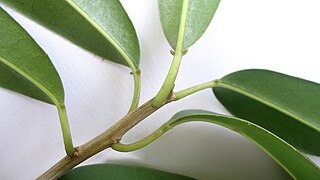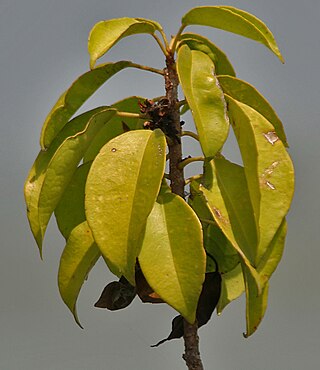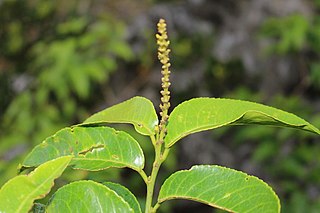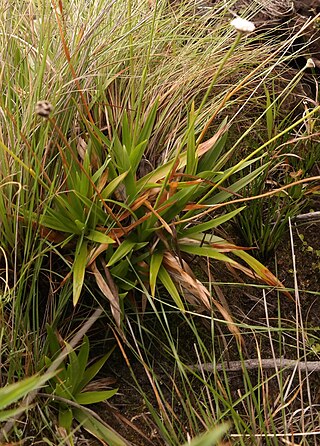
Sapium is a genus of flowering plants in the family Euphorbiaceae. It is widespread across most of Latin America and the West Indies. Many Old World species were formerly included in the genus, but recent authors have redistributed all the Old World species into other genera.
Crotonogynopsis is a plant genus of the family Euphorbiaceae first described as a genus in 1899. It is native to tropical Africa.
- Crotonogynopsis akeassiiJ.Léonard - Ivory Coast, Ghana
- Crotonogynopsis usambaricaPax - Cameroon, Zaïre, Uganda, Tanzania, Mozambique

Necepsia is a plant genus of the family Euphorbiaceae first described as a genus in 1910. It is native to Madagascar and to tropical Africa.
- Necepsia afzeliiPrain - Liberia, Sierra Leone, Ivory Coast, Ghana, Cameroon, Congo, Cabinda, Gabon
- Necepsia castaneifolia(Baill.) Bouchat & J.Léonard - Tanzania, Zimbabwe, Madagascar
- Necepsia zairensisBouchat & J.Léonard - Congo, Zaire

Tragia is a genus of flowering plants in the spurge family, Euphorbiaceae. It is widespread across North and South America, Africa, the Arabian Peninsula, the Indian Subcontinent, northern Australia, and to various islands in the Caribbean and in the Indian Ocean.

Argomuellera is a genus of plant of the family Euphorbiaceae first described as a genus in 1894. It is native to sub-Saharan Africa, Madagascar, and the Comoros Islands.
Pycnocoma is a genus of plant of the family Euphorbiaceae first described as a genus in 1849. It is native to tropical Africa and Madagascar.
Grossera is a plant genus of the family Euphorbiaceae first described as a genus in 1903. It is native to Madagascar and to mainland tropical Africa. It is dioecious.
- Grossera angustifoliaBarbera&Riina - Equatorial Guinea
- Grossera elongataHutch. - Príncipe
- Grossera glomeratospicataJ.Léonard - East Congo
- Grossera macranthaPax - East Congo, West Congo, Cameroon, Central African Rep.
- Grossera majorPax - Cameroon
- Grossera multinervisJ.Léonard - East Congo, São Tomé
- Grossera paniculataPax - West Congo, Cameroon, Gabon
- Grossera perrieriLeandri - Madagascar
- Grossera vigneiHoyle - Ivory Coast, Ghana, West Congo

Tannodia is a plant genus of the family Euphorbiaceae first described as a genus in 1861. It is native to Africa, Madagascar, and Comoros. It is dioecious.
- Tannodia congolensis - Zaïre
- Tannodia cordifolia - Comoros, Madagascar
- Tannodia grandiflora - Diana Region in Madagascar
- Tannodia nitida - Atsinanana in Madagascar
- Tannodia obovata - Atsinanana in Madagascar
- Tannodia pennivenia - Atsinanana in Madagascar
- Tannodia perrieri - Madagascar
- Tannodia swynnertonii - Tanzania, Mozambique, Zimbabwe
- Tannodia tenuifolia - Kenya, Tanzania, Malawi, Mozambique, Zimbabwe, Zambia

Neoboutonia is a plant genus of the family Euphorbiaceae first described as a genus in 1864. It is the only genus in subtribe Neoboutoniinae, and native to tropical Africa. It is dioecious.
- Neoboutonia macrocalyx Pax - Burundi, Cameroon, Rwanda, Zaire, Kenya, Tanzania, Uganda, Malawi, Zambia, Zimbabwe
- Neoboutonia manniiBenth. & Hook.f. - tropical Africa from Liberia to Mozambique
- Neoboutonia melleri(Müll.Arg.) Prain - tropical Africa from Nigeria to Mozambique

Excoecaria is a plant genus of the family Euphorbiaceae, formally described by Linnaeus in 1759. The genus is native to the Old World Tropics.

Shirakiopsis is a genus of flowering plants in the family Euphorbiaceae first described as a genus in 1999. There are six known species, 3 native to tropical Asia and 3 to tropical Africa.
Thecacoris is a genus of flowering plant belonging to the family Phyllanthaceae first described as a genus in 1821. It is native to tropical Africa and Madagascar. It is dioecious, with male and female flowers on separate plants, although it may rarely be monoecious.

Uapaca is a genus of plant, in the family Phyllanthaceae first described as a genus in 1858. It is the only genus comprised in the tribe Uapaceae. The genus is native to Africa and Madagascar. Uapaca is dioecious, with male and female flowers on separate plants.

Angraecopsis is a genus of plants in the family Orchidaceae. It was first described by Fritz Kraenzlin in 1900 and given its name on account with the genus' similarity to Angraecum species. Angraecopsis are native to Africa, Madagascar, Réunion, Mauritius and the Comoros. The growth habit is rather small and the leaves emerge from a woody stem.

Sacciolepis is a genus of plants in the grass family. Cupscale grass is a common name for plants in this genus.

Microcoelia is a genus of orchids native to sub-Saharan Africa as well as to Madagascar and other islands of the Indian Ocean.
- Microcoelia aphylla(Thouars) Summerh. - from Kenya and Uganda south to KwaZulu-Natal, plus Madagascar, Mauritius and Réunion
- Microcoelia aurantiaca(Schltr.) Summerh. - Madagascar
- Microcoelia bispiculataL.Jonss. - Madagascar
- Microcoelia bulbocalcarataL.Jonss. - Príncipe, Cameroon, Gabon, Uganda, Rwanda
- Microcoelia caespitosa(Rolfe) Summerh. in J.Hutchinson & J.M.Dalziel - western and central Africa from Liberia to Zaïre and Uganda
- Microcoelia corallinaSummerh. - Tanzania, Mozambique, Malawi
- Microcoelia cornuta(Ridl.) Carlsward - Madagascar, Comoros
- Microcoelia decaryanaL.Jonss. - Madagascar
- Microcoelia dolichorhiza(Schltr.) Summerh. - Madagascar
- Microcoelia elliotii(Finet) Summerh. - Madagascar
- Microcoelia exilisLindl. - from Kenya and Uganda south to KwaZulu-Natal, plus Madagascar
- Microcoelia gilpinae(Rchb.f. & S.Moore) Summerh. - Madagascar
- Microcoelia globulosa(Hochst.) L.Jonss. - from Nigeria east to Eritrea, south to Angola and Zimbabwe
- Microcoelia hirschbergiiSummerh. - Zaïre, Zambia
- Microcoelia jonssoniiSzlach. & Olszewski - Central African Republic
- Microcoelia koehleri(Schltr.) Summerh. - from Nigeria to Tanzania, south to Zimbabwe
- Microcoelia konduensis(De Wild.) Summerh - western and central Africa
- Microcoelia leptostele(Summerh.) L.Jonss. - Central African Republic, Zaïre
- Microcoelia macrantha(H.Perrier) Summerh. - Madagascar
- Microcoelia macrorhynchia(Schltr.) Summerh. in J.Hutchinson & J.M.Dalziel - central Africa
- Microcoelia megalorrhiza(Rchb.f.) Summerh. - Kenya, Tanzania, Malawi
- Microcoelia microglossaSummerh. - central Africa
- Microcoelia moreauaeL.Jonss - Kenya, Tanzania, Zimbabwe
- Microcoelia nyungwensisL.Jonss. - Rwanda
- Microcoelia obovataSummerh. - from Kenya south to KwaZulu-Natal
- Microcoelia ornithocephalaP.J.Cribb - Malawi
- Microcoelia perrieri(Finet) Summerh. - Madagascar
- Microcoelia physophora(Rchb.f.) Summerh. - Kenya, Tanzania, Madagascar
- Microcoelia sanfordiiL.Jonss - Cameroon
- Microcoelia smithii(Rolfe) Summerh. - Kenya, Tanzania, Malawi
- Microcoelia stolzii(Schltr.) Summerh. - Kenya, Tanzania, Malawi, Mozambique, Zambia, Zimbabwe

Aeollanthus (rocksage) is a genus in the mint family, Lamiaceae. All the species are native to Africa.

Mesanthemum is a genus of flowering plants in the family Eriocaulaceae, first described in 1856. It is native to tropical Africa and Madagascar.

Tetradenia (gingerbush) is a genus of plants in the family Lamiaceae, first described in 1830. It is native to Africa, including Madagascar.
- Tetradenia bainesii(N.E.Br.) Phillipson & C.F.Steyn - Zimbabwe, Mozambique, Eswatini, KwaZulu-Natal
- Tetradenia barberae(N.E.Br.) Codd - Cape Province
- Tetradenia brevispicata(N.E.Br.) Codd - Zimbabwe, Namibia, Botswana, Transvaal
- Tetradenia clementianaPhillipson - Madagascar
- Tetradenia cordataPhillipson - Madagascar
- Tetradenia discolorPhillipson - Zambia, Zaire, Zimbabwe, Malawi, Tanzania
- Tetradenia falafaPhillipson - Madagascar
- Tetradenia fruticosaBenth. - Madagascar
- Tetradenia galpinii(N.E.Br.) Phillipson & C.F.Steyn - southeast Africa from Tanzania to Eswatini
- Tetradenia goudotiiBriq. - Madagascar
- Tetradenia herbacea Phillipson - Madagascar
- Tetradenia hildeanaPhillipson - Madagascar
- Tetradenia isaloensisPhillipson - Madagascar
- Tetradenia kaokoensisvan Jaarsv. & A.E.van Wyk - Namibia
- Tetradenia multiflora(Benth.) Phillipson - Ethiopia
- Tetradenia nervosaCodd - Madagascar
- Tetradenia riparia(Hochst.) Codd - southern Africa from Angola + Malawi to Eswatini
- Tetradenia tanganyikaePhillipson - Malawi, Tanzania, Zambia
- Tetradenia tuberosaT.J.Edwards - KwaZulu-Natal
- Tetradenia urticifolia(Baker) Phillipson - eastern + central Africa from Sudan + Eritrea south to Zaire and Tanzania

Girardinia is a genus of flowering plants belonging to the family Urticaceae.
















